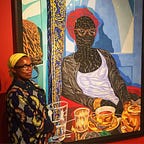How one is seen (as black) and, therefore, what one sees (in a white world) is always already crucial to one’s existence as an Afro-American.
(Michele Wallace, “Modernism, Postmodernism, and the Problem of the Visual in Afro-American Culture”)
To look is an act of choice.
(John Berger, Ways of Seeing)
And so the black artist in some way, spoken or not, contends with death, races against it, writes amongst its ghosts who we call ancestors. We listen for the silences and make that art.
(Elizabeth Alexander, The Light of the World)
Blackness…is not only her subject; it is also her question.
(Claudia Rankine, “A New Grammar for Blackness”)
Black is…and Black ain’t… (Ralph Ellison, Invisible Man)
What is Black Art? Why is Black Art? Where is Black Art? When is Black Art? Since at least the start of the twentieth century, “Black Art” has been the subject of heated debates about its purposes and preoccupations, its aims (or aimlessness), its practitioners, its subjects, its audiences, its critics, its ownership, its temporalities and locations, its borders and boundarylessness, its possibilities and limitations.
Over the course of the last two months, a group of us (under the rubric of African American Studies 240) have taken up black art as both our subject and our question. Our particular concern is how visual culture — modes of representation, artistic products and ways of seeing — produces meanings about black bodies. How is blackness produced, negotiated, refuted, reformed and imagined through a host of visual modes? How is “blackness” itself a scopic regime, that is a structured and structuring way of seeing?
The real question then is, How is Black Art?
What follows are a series of short essays on individual artworks. We are committed to slow looking, decolonized vision, and greater freedom.
